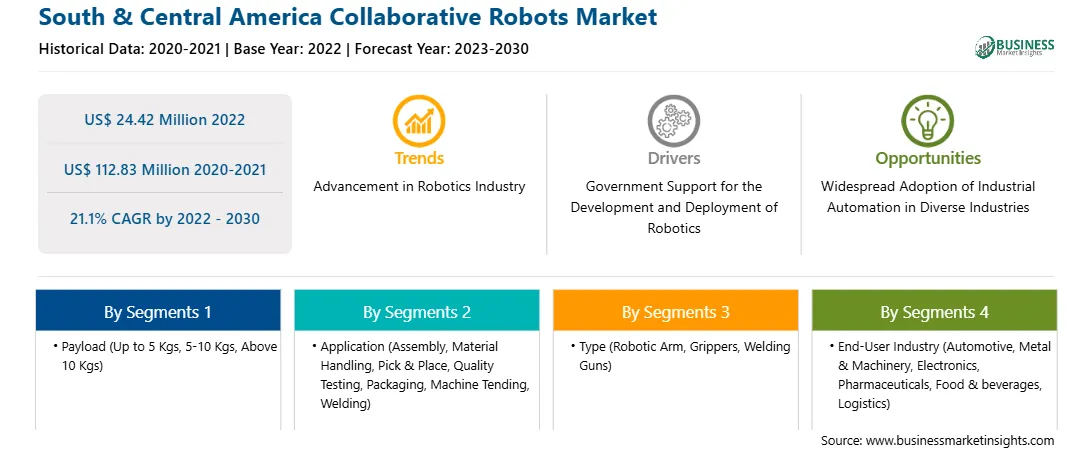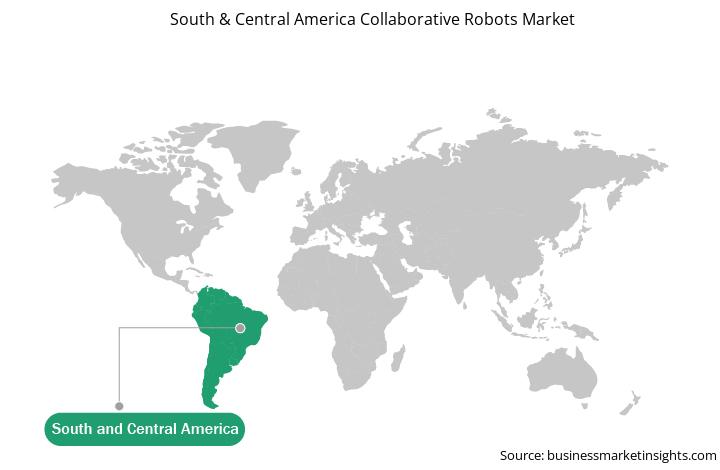In the coming years as machine learning algorithms and other technologies such as neuromorphic chips improvise their capabilities to enable smarter robots, the collaborative robots soon would be able to perform the tasks that only humans can do now, in fact in a better way. These robots will then be able to access a plethora of database and recognize machines, people, and parts, further enabling them to derive critical insights and act upon them. This is anticipated to be a key trend for the collaborative robots over the coming years.
In addition, the players in this industry are significantly investing in the development of collaborative robots integrated with artificial intelligence and machine learning. The integration of artificial intelligence in these robots will further enhance the support to the human operators, which will be beneficial for countries with inadequate and expensive labor force.
South American region comprises of several emerging economies, which have been experiencing tremendous growth in their manufacturing sector. The automotive sector of Brazil is witnessing the highest adoption, as the country comprises of manufacturing facilities of several automotive players such as Fiat, General Motors, Honda, Volkswagen, Renault and Peugeot among others. Further, other manufacturing industries in the country include electronics, aerospace, and food and beverages. As per government sources, Brazil is anticipated to witness a high growth in the country’s automobile production capacity during the coming years. Moreover, government of other emerging economies in the region are taking several initiatives to support industrial growth. For instance, Argentina is concentrating on attracting FDIs by taking several initiatives such as easing import restrictions, signing international bilateral agreements, no restriction on foreign investment and other such initiatives. Such initiatives are expected to help in the development of businesses in the South American region.
The South & Central America collaborative robots market is segmented into payload, application, type, end-user industry, and country.
Based on payload, the South & Central America collaborative robots market is segmented into Up to 5 Kgs, 5-10 Kgs, and above 10 Kgs. The above 10 Kgs segment held a largest share of the South & Central America collaborative robots market in 2022.
Based on application, the South & Central America collaborative robots market is segmented into assembly, material handling, pick & place, quality testing, packaging, machine tending, welding, and others. The material handling segment held the largest share of the South & Central America collaborative robots market in 2022.
Based on type, the South & Central America collaborative robots market is segmented into robotic arm, grippers, welding guns, and others. The robotic arm segment held largest share of South & Central America collaborative robots market in 2022.
Based on end-user industry, the South & Central America collaborative robots market is automotive, metal & machinery, electronics, pharmaceuticals, food & beverages, logistics, and others. The automotive segment held largest share of South & Central America collaborative robots market in 2022.
Based on country, the South & Central America collaborative robots market is segmented into Brazil, Argentina, and the Rest of South& Central America. Brazil dominated the share of the South & Central America collaborative robots market in 2022.
Kuka AG, Yaskawa America Inc, Aubo (Beijing) Robotics Technology Co Ltd, Doosan Robotics Inc, Fanuc Corp, ABB Ltd, Universal Robots AS and Kawasaki Heavy Industries Ltd are some of the leading companies operating in the South & Central America collaborative robots market.
Strategic insights for the South & Central America Collaborative Robots provides data-driven analysis of the industry landscape, including current trends, key players, and regional nuances. These insights offer actionable recommendations, enabling readers to differentiate themselves from competitors by identifying untapped segments or developing unique value propositions. Leveraging data analytics, these insights help industry players anticipate the market shifts, whether investors, manufacturers, or other stakeholders. A future-oriented perspective is essential, helping stakeholders anticipate market shifts and position themselves for long-term success in this dynamic region. Ultimately, effective strategic insights empower readers to make informed decisions that drive profitability and achieve their business objectives within the market.

| Report Attribute | Details |
|---|---|
| Market size in 2022 | US$ 24.42 Million |
| Market Size by 2030 | US$ 112.83 Million |
| Global CAGR (2022 - 2030) | 21.1% |
| Historical Data | 2020-2021 |
| Forecast period | 2023-2030 |
| Segments Covered |
By Payload
|
| Regions and Countries Covered | South and Central America
|
| Market leaders and key company profiles |
The geographic scope of the South & Central America Collaborative Robots refers to the specific areas in which a business operates and competes. Understanding local distinctions, such as diverse consumer preferences (e.g., demand for specific plug types or battery backup durations), varying economic conditions, and regulatory environments, is crucial for tailoring strategies to specific markets. Businesses can expand their reach by identifying underserved areas or adapting their offerings to meet local demands. A clear market focus allows for more effective resource allocation, targeted marketing campaigns, and better positioning against local competitors, ultimately driving growth in those targeted areas.

The South & Central America Collaborative Robots Market is valued at US$ 24.42 Million in 2022, it is projected to reach US$ 112.83 Million by 2030.
As per our report South & Central America Collaborative Robots Market, the market size is valued at US$ 24.42 Million in 2022, projecting it to reach US$ 112.83 Million by 2030. This translates to a CAGR of approximately 21.1% during the forecast period.
The South & Central America Collaborative Robots Market report typically cover these key segments-
The historic period, base year, and forecast period can vary slightly depending on the specific market research report. However, for the South & Central America Collaborative Robots Market report:
The South & Central America Collaborative Robots Market is populated by several key players, each contributing to its growth and innovation. Some of the major players include:
The South & Central America Collaborative Robots Market report is valuable for diverse stakeholders, including:
Essentially, anyone involved in or considering involvement in the South & Central America Collaborative Robots Market value chain can benefit from the information contained in a comprehensive market report.